#Theodora the Empress of Byzantium
Photo

1900 Sarah Bernhardt in character as Theodora the Empress of Byzantium (Empress Theodora) in "Theodora: A Drama in Five Acts and Eight Tableau" (1885) by Victorien Sardou. Premiered: Theatre de la Porte Saint-Martin in Paris, France.
Sardou's enthusiasm for historical authenticity was shared by his star. Weeks before ordering her costumes, she journed to Ravenna and stood long hours in the Church of San Vitale studying the magnificent mosaics with their startling portraits of Theodora and Justinian staring menacingly forth from barbaric gold. She made sketches of every robe, every fold, every detail or ornamentation. When she returned to Paris she had completed in detail a dressmaker's design for each outfit, as well as those for her stage jeweller, even to that death-dealing hairpin. Her wardrobe along cost more than the average production. Her costumer figured out that toiling in her work rooms she and her assistants had sewn on by hand more than 4,500 'gems'. (x)
Her costume is a replica of the celebrated mosaic of the Byzantine Virgin in the Church of Ravenna -- her robe is yellow satin embroidered with topazes; her coiffure is ablaze with jewels, and in her hand she carries a white lily, which tradition says was Théodora's favourite flower. The Empress seats herself on a couch of tigers' skins, and gives audience to her courtiers and to ambassadors from foreign lands.
#1900#drama#sarah bernhardt#oriental costum#costume#oriental#byzantine costume#byzantine#theodora#empress theodora#Theodora the Empress of Byzantium#byzantine empress#feminist#victorien sardou#theatre de la porte saint-martin#paris#france#french actress#bernhardt#la emperatriz theodora#the empress theodora
19 notes
·
View notes
Text

Justinian and Theodora romance sketch! I totally love these two as a couple-- the courtesan that married a prince!-- and there's not much art for them out there. So here it is, @byzantine-suggestions and @margaretkart!
#justinian#justinian and theodora#theodora#empress theodora#art#illustration#sketchbook#sketch#romance art#byzantine empire#byzantium#ancient rome
74 notes
·
View notes
Text
Empress Theodora entering Hagia Soph..
oh wait, it's Alicent.
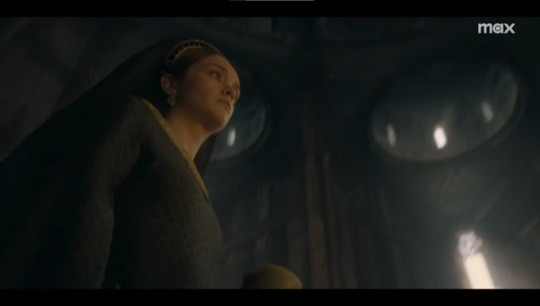
#byzantine#byzantium#game of thrones#house of the dragon#hotd#alicent hightower#rhaenyra targaryen#daemon targaryen#hagia sophia#constantinople#roman empire#late roman empire#late antiquity#house targaryen#team green#team black#hbo#hbo max#theodora#justinian#empress
21 notes
·
View notes
Text

The Empress Theodora by Jean-Joseph Benjamin-Constant
#empress theodora#art#history#byzantine#byzantium#byzantines#constantinople#painting#europe#christianity#empress#theodora#jean joseph benjamin constant
379 notes
·
View notes
Text

Et voila! I know you’ve all been waiting for it 🤭🤭
#byzantium#byzantine empire#byzantine empress#theodora palaiologina#anna of savoy#maria of trebizond#nicaean empire#empire of nicaea#13th century#14th century#15th century#history art#digital art#pride#lesbian#trans pride#pride art#greek tag#roman tag#italian tag#german tag#rus tag#bulgar tag#outremer#hungary tag#armenia tag#france tag
10 notes
·
View notes
Text
empress theodora deserves a tv show...being a sex worker who has an emperor become down horrendous for her...battling her heinous mother in law...pioneering rights for female sex workers...becoming an empress...where is her three season, eight episodes PER season, HBO television show??
#empress theodora#emperor justinian#history#byzantine#byzantium#empire#random#shitpost#history shitpost#someone get this woman a tv show PLEASE
43 notes
·
View notes
Photo
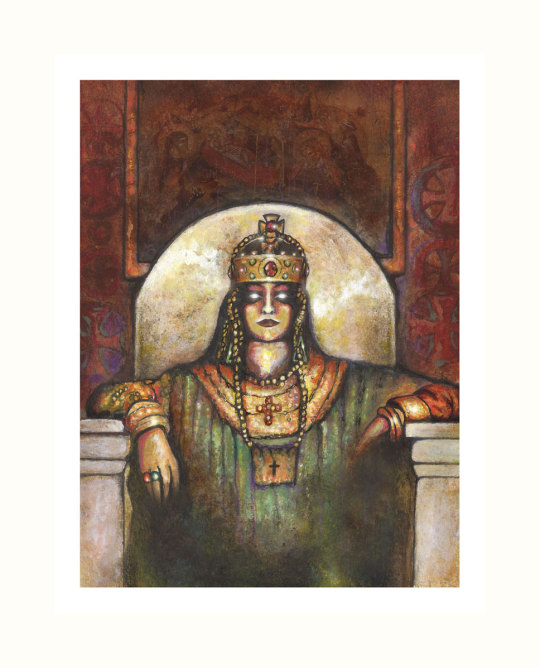

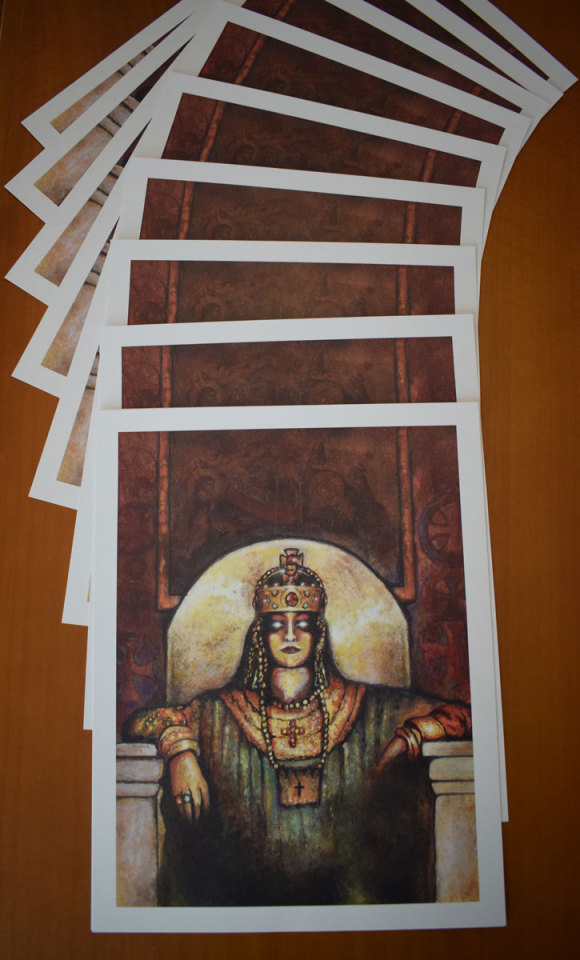
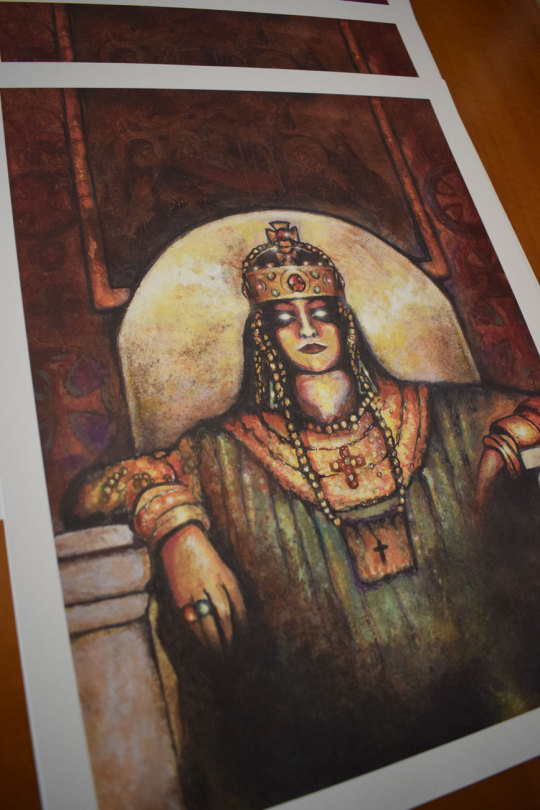
Empress Thedora - Digital Print on Velvet 300 gr paper
https://www.etsy.com/listing/1299026450/empress-thedora-digital-print-on-velvet?click_key=aebefab431bdb6efaec6993a018d9220f32d94ca%3A1299026450&click_sum=ad845102&ref=shop_home_active_1
12 notes
·
View notes
Text
Ravenna - the church of San Vitale - part 2
The most famous mosaics in this church are the ones on either side of the altar depicting (on the left) the Byzantine Emperor Justinian and (on the right) his wife Theodora.
Both are part of processions offering gifts to San Vitale. Justinian, carrying an empty basked, is accompanied by soldiers and priests, including the local bishop, Maximianus, the only one to be named on the mosaics. The…

View On WordPress
4 notes
·
View notes
Photo
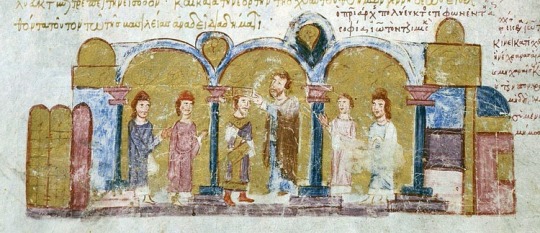
John I Tzimiskes
John I Tzimiskes was Byzantine emperor from 969 to 976 CE. Although he took the throne by murdering his predecessor Nikephoros II Phokas, John was a popular emperor. A skilled general and a competent politician, he is known for expanding Byzantium's borders to the Danube River in the west and further into Syria in the east.
Rise to Power
John was related to the landed military elite families of Byzantine Anatolia, including the powerful Phokas and Kourkouas families. He was married to a woman from the Skleros family, who died sometime before 969 CE. After John's uncle, Nikephoros Phokas, took command of the Byzantine armies in 955 CE, he gave a forward command appointment to John. John was described as a short but handsome general. He led multiple armies against the forces of Sayf al-Dawla (r. 945-967 CE), the powerful Emir of Aleppo, under Nikephoros' overall command. He was known for an aggressive style of command and, like Nikephoros himself, he was a highly successful general.
John was among the troops that proclaimed Nikephoros II Phokas (r. 963-969 CE) emperor in 963 CE. Nikephoros appointed John domestikos, or commander, of the East. John was one of the main commanders under Nikephoros in Cilicia and Syria, but after 965 CE Nikephoros distrusted him, stripped him of his titles, and placed him under house arrest.
On the night of December 10-11, 969 CE, John broke into the imperial palace with inside help and murdered Nikephoros with his co-conspirators. John immediately summoned Basil Lekapenos, the parakoimomenos, or director of the palace, to help secure John as the new emperor. By the morning, John had been crowned co-emperor with the young princes of the Macedonian Dynasty, the future Basil II (r. 976-1025 CE) and Constantine VIII (r. 1025-1028 CE). John prevented any looting from taking place following the coup, and other members of the Phokas family were placed under arrest and exiled. The fact that Nikephoros was already dead and that he was so unpopular allowed John to be accepted as emperor without any public outcry.
The Patriarch of Constantinople, Polyeuktos, agreed to crown John emperor in exchange for him canceling Nikephoros' decrees about the Church and blaming Empress Theophano, the mother of Basil and Constantine and widow of Romanos II (r. 959-963 CE) and Nikephoros, for instigating the murder of Nikephoros. It was even alleged that Theophano had had an affair with John before Nikephoros' murder. Theophano was then exiled by Basil the parakoimomenos. After being crowned, John married one of Romanos II's (r. 959-963 CE) sisters, Theodora, connecting him to the reigning Macedonian Dynasty.
Continue reading...
16 notes
·
View notes
Text
So today I learnt Destiny has a son? ... I'm gonna be honest here Destiny. You were the last one I expected to be out covorting with humanity. Even in 'it's a prophecy lovechild' sence. But hey, Empress Theodora, what a woman! Kudos! You go sir!

"Destiny has a son, John Ryder (from his spin-off miniseries Destiny - A Chronicle of Deaths) by the Byzantium Empress Theodora. He’s not a child of the Endless through sexual intercourse like Miranda Walker and Orpheus are, more so the result of the will of a prophecy. But both Destiny and John recognize the relationship. He is called the son of Destiny and is Pestilence, Horseman of the Apocalypse."
#destiny of the endless#The endless#Children of the endless#The sandman#pestilence#the four horsemen
57 notes
·
View notes
Note
Which Byzantine figures do you consider underrated? As someone who has slowly started to learn more about Byzantium, names like Constantine the Great, Justinian the Great, Theodora, Irene of Athens, Anne Komnene, Nikephoros Phokas, Constantine Palaiologos, Tsimiski, Basil, Zoe and Theodora Porprhyrogennita and Theophano are familiar, but do you have any other recommendations (sorry if I misspelled some)?
Below are a few Byzantine historical figures I find very interesting currently:

Flavius Belisarius (c.500 - 565)
While Justinian the Great is one of the most significant emperors in history, his accomplishments would simply not be the same, if he did not have Belisarius as his military commander. He was of uncertain descent (possibly Thracian, Illyrian or less so Greek) but his mother tongue was certainly Latin. Belisarius reconquered Rome and Italy while severely outnumbered during the Gothic War, defeated the Sassanids in the Iberian War, conquered the Vandal Kingdom in North Africa, successfully repulsed the Huns and defended the empire from the Persians and the Arabs. The Byzantine Empire reached its largest surface mostly thanks to Belisarius. A more controversial point in his life was when he was commanded to suppress the notorious Nika riots against Justinian, which ended in a massacre of dozens of thousands civillians. Belisarius was above all a strategist; he didn't mind fleeing the battle or using trickery in order to win a war. Despite his analytical mind in battle, he resolutely wasn't one in the affairs of the palace. Belisarius was married and quite smitten with Antonina, who had the favour of Empress Theodora, and thus felt safe to be totally unhinged. Schemes happening in the palace would sometimes find a scapegoat in Belisarius, who was likely the most genuinely devoted person to the emperor. As a result, Belisarius was often not treated well by the emperor and the secretaries and he was cheated on by his wife. He was even led to trial for betrayal, although Justinian eventually pardoned him. According to legend, Justinian first blinded him and then pardoned him, although lately the historicity of this is questioned. What's certain is that Belisarius didn't receive the respect he deserved in his personal life but he earned the respect of the historians, who consider him one of the best military leaders in history.
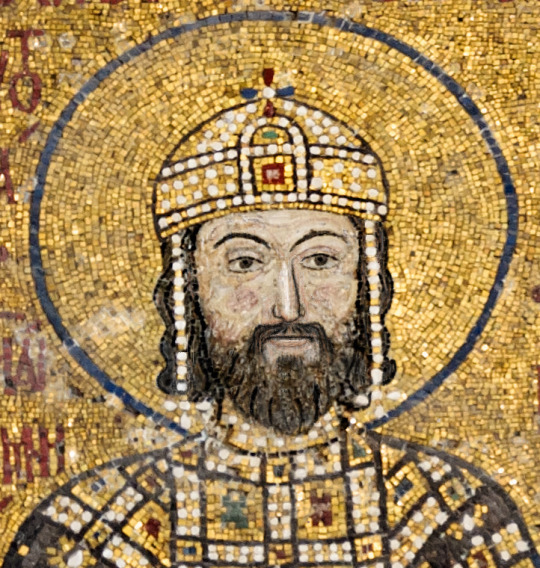
Ioannis II Komnenos (1087 - 1143)
Known as Kaloioannis (John the Good / Beautiful), Ioannis is considered the best emperor from the Greek dynasty of the Komneni. Ioannis was not beautiful, he must have been rather unattractive actually, but he earned the title because of his noble character. He was the brother of Anna Komnene, he was the one she tried to poison so that she would ascend to the throne instead. Ioannis forgave her. Ioannis was very just, modest and pious and would only use his imperial luxuries during diplomat visits. He was married to Irene of Hungary. Whether it was because of his piety, his natural predesposition or a different orientation, Ioannis was not very interested in the joys of marriage. However, he remained devoted and faithful to her. It is notable that during his long reign, not a single person was sentenced to death or mutilation, at a time that this would have been the norm for criminals and traitors. Despite all that, Ioannis was actually a great military leader once need arose. His biggest goal as an emperor was to undo the damage from the Battle of Manzikert 50 years prior. Indeed he forced Seljuk Turks to assume a defensive stance and did expand the empire's power to the east again. The Byzantine population increased during his reign. It is certain that Ioannis left the empire significantly better than how he received it. Some sources suggest that Ioannis' noble character was an inspiration to the people of his empire.

Michael Psellos (1017 - 1078)
Psellos was a Greek man of great knowledge and intellect and a questionable character. He did it all; he was a monk, a writer, a philosopher, a judge, a music theorist, an imperial advisor and courtier and a historian. His skill in literally everything led him quickly to the position of the leading professor in the University of Constantinople and that of secretary in the imperial court. His political influence was immense and he saw many emperors succeed each other while he maintained his position as political advisor. Because a big part of his work is autobiographical, it is unclear whether some of his claims are entirely reliable; Psellos was prone to vanity and sarcasm against those who did not favour him. Psellos studied Plato thoroughly, so much so that at times his faith in Christian Orthodoxy was questioned. *Fun fact: Psellos was apparently good at everything except Latin. His Latin was so rusty he confused Cicero with Caesar!
He looks like a Greek Rasputin in his painting above lol Anyway, he was manipulative but he wasn't nowhere near as controversial as Rasputin, let me be clear.
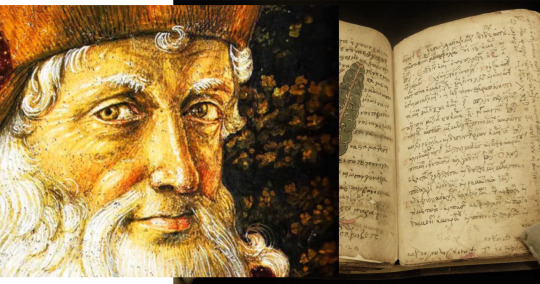
Georgios Gemistos Plethon (c. 1355 - 1452/1454)
Gemistos Plethon was a scholar and philosopher of the late Byzantine era. He was the pioneer of the revival of Greek scholarship in Western Europe. He was secretly not Christian, he believed in the Ancient Greek gods. Plethon admired Platon too. (It's Platon in Greek.) So much so that he added "Plethon" next to his surname Gemistos, which means pretty much the same thing (full) except more archaic and more similar to Plato(n)'s name! He was imperial advisor to the Palaeologi dynasty who at the time were reigning from Mystras, as the empire was dissolving. Everyone suspected his pagan beliefs but he was so influential and important that nobody dared confront him about it. He taught philosophy, astronomy, history, geography and classical literature. He was invited to Florence, Italy to teach Plato and Aristotle and help Florentines understand the differences between the two philosophies. Plethon died in Mystras shortly before or after the Fall of Constantinople. We don't know if he lived enough to see the empire fall. Around 10 years later, some of his Italian followers stole his remains from Mystras and interred him in Rimini, Northern Italy, so that he could "rest amongst free men". Plethon's vision was the revival of the Byzantine Empire, founded on a utopian Hellenic (and not universal) system of government. In one of his speeches, he said "We are Hellenes by race and culture". He is at the forefront of historical studies exploring the connections between Byzantine and Modern Greek identity.

Laonikos Chalkokondyles (c. 1430 - 1470)
Chalkokondyles was an Athenian native, from a prominent old family of the city. He was a historian who witnessed the last years of the Byzantine and the early years of the Ottoman Empire. He was sometimes employed by the Byzantine emperors as a messenger to the Sultan Mehmed II, not without drama. Chalkokondyles wrote in detail about 150 years prior to his lifetime. He described the fall of the Byzantine Empire, he offered a profile of the Ottoman Turks, and he wrote about their conquest of the Venetians and Matthias the King of Hungary. He also explored the civilisations of England, France and Germany. I didn't know about him until I read a great Romanian biography of Vlad Tepes the Impaler (you know, the inspiration of Count Dracula). Chalkokondyles's input is extensive and invaluable for this book; he wrote about Vlad's ancestors and the fights of the Wallachian princes with the Ottomans. His style of writing was mostly clear and simple, styled after Thucydides. He called the Byzantines “Hellenes” and did not use the term "Rhomaioi" (Romans in Greek) for them.
#byzantine empire#eastern roman empire#history#medieval history#middle ages#byzantine history#greek history#greeks#greek people#attichoney4u#ask#long post#tw long#long text#tw long text#tw long post
44 notes
·
View notes
Photo
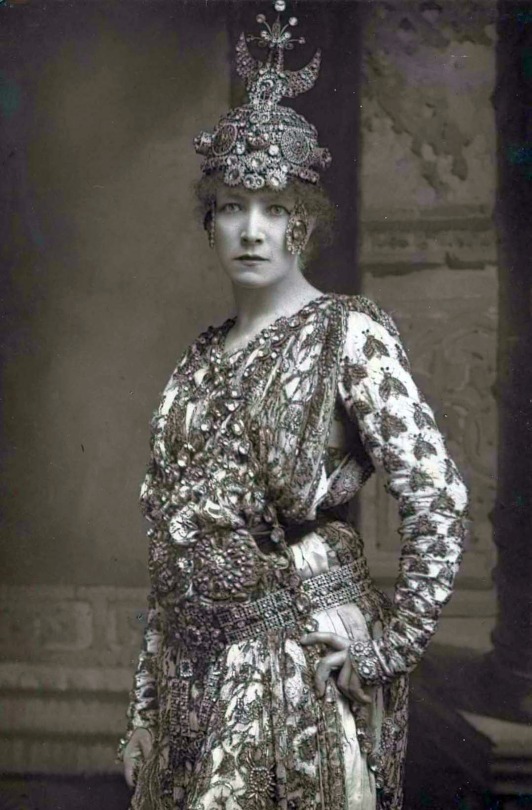
1900 William Downey, Sarah Bernhardt in character as Theodora the Empress of Byzantium (Empress Theodora) in "Theodora: A Drama in Five Acts and Eight Tableau" (1885) by Victorien Sardou. Premiered: Theatre de la Porte Saint-Martin in Paris.
Sardou's enthusiasm for historical authenticity was shared by his star. Weeks before ordering her costumes, she journed to Ravenna and stood long hours in the Church of San Vitale studying the magnificent mosaics with their startling portraits of Theodora and Justinian staring menacingly forth from barbaric gold. She made sketches of every robe, every fold, every detail or ornamentation. When she returned to Paris she had completed in detail a dressmaker's design for each outfit, as well as those for her stage jeweller, even to that death-dealing hairpin. Her wardrobe along cost more than the average production. Her costumer figured out that toiling in her work rooms she and her assistants had sewn on by hand more than 4,500 'gems'. (x)
#1900#drama#william downey#sarah bernhardt#in character#empress theodora#Theodora the Empress of Byzantium#french actress#french#costume#oriental#oriental costume#theodora#byzantine#feminist#la emperatriz theodora#the empress theodora
8 notes
·
View notes
Text
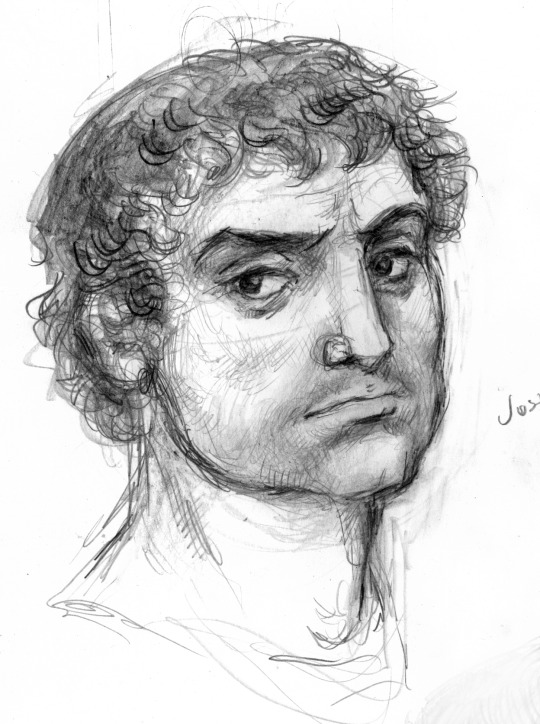
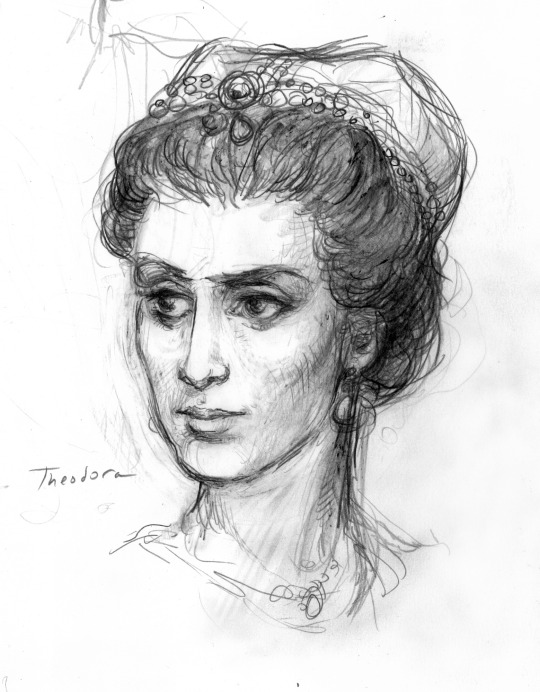
Good-bye 2023, hello 2024! One of my New Year's Resolutions is to draw more (whispers-- and to catch up on my commissions) and here are sketches of Byzantine emperor Justinian and his wife Theodora, based on the famous San Vitale mosaics and these busts of Justinian (and the bust of Theodora in Milan here).
#justinian#theodora#empress theodora#illustration#art#sketchbook#sketch#byzantium#byzantine empire#byzantine#justinian and theodora
90 notes
·
View notes
Text
Theodora of Byzantium means so much to me. She rose from rags to riches, was a teenage mother who became empress. And she wasn't just a consort, Justinian treated her as an equal. She was a cunning politician who fought for women's rights, was a successful diplomat, supposedly persuaded Justinian not to flee during their darkest hour (Nika), and when the plague struck SHE was the one who kept everything together.
Absolutely unparalleled.
9 notes
·
View notes
Text
OK we are actually doing this! Here I have listed the contestants of the greek tumblr sexywomen poll, complementary to @sugaroto 's sexyman polls. This polls is more accurately the "greek iconicwomen of tumblr" lol. I will be updating this list and providing links when a new poll is posted
Round 1
Aliki Vougiouklaki (old actress) vs Aggela Ioakimidou (tv show: Στο Παρά Πέντε/ In the Nick of Time)
Aspasia (Pericles' wife but great in her own way) vs Vicky Kaya (tv presenter)
Sappho (poet) vs Medusa (mythical gorgon)
Xena (tv show: Xena: Warrior Princess) vs Katerina Sakelaropoulou (judge/greek president)
Eleni Vlachaki (tv show: Κωνσταντίνου και Ελένης/Konstantinou and Eleni's) vs Maria Solomou (actress)
ZoePre (YouTuber/podcast host) vs Zoumpoulia Abadjidou (tv show: Στο Παρά Πέντε/ In the Nick of Time)
Matina Mantarinaki (tv show: Κωνσταντίνου και Ελένης/Konstantinou and Eleni's) vs Σαββατογεννημένες/ Women-born -on-Saturday (tv show cast) (yes I am putting them all as one entry 'cause we couldn't decide)
Aglaia Karagiozi (shadow puppet theater) vs Aglaia (tv show: Το Καφέ της Χαράς/ Hara's Caffe)
Eleni Foureira (singer) vs Sophia Hadjipanteli (part of the GNTM jury)
Amalia Antonopoulou (tv show: Στο Παρά Πέντε/ In the Nick of Time) vs Sophia Laskaridou (painter)
Eleni Menegaki (tv presenter) vs Eleutheria Karadimou (goddess amateur author, director, screenwriter, actress ect)
Arleta (singer) vs Maria Lekaki (actress)
Mimi Denissi (actress) vs Empress Theodora (byzantium empress)
Katerina Lehou (actress) vs Laskarina Bouboulina (greek independence fighter)
Mascot of Papadopoulou biscuits vs mascot of Nounou milk (greek enough i think?)
Soso (tv show: Εγκλήματα/ Crimes) vs Vicky Georgiou (tv show: Ευτιχισμένοι Μαζί/ Happy Together)
Jenny Karezi (old actress) vs Christina Markatou (tv show: Dolce Vita)
Angeliki Nikolouli (tv presenter, researcher about crime cases) vs the head builder's wife (character in the Bridge of Arta story)
Bessy Argyraki (singer) vs Manto Maurogenous (greek indepence fighter)
Vefa Alexiadou (tv presenter/food specialist) vs Hypatia of Alexandria (philosopher, astronomer, mathematician)
Petroula Kostidou vs Sofia Vempo (old singer/actress)
Maria Callas (singer) vs Helen of Troy (mainly the Illiad)
Penelope Delta (author) vs Melina Merkouri (old actress/activist/politician)
Marina Diamandis vs Rena Vlahopoulou
#greek sexywomen of tumblr#i decided against adding the goddesses because we don't need another μήλο της έριδος situation#and out of respect#as i said this is mainly the greek iconic women. most of them are known for way more than their looks#the polls are not up yet btw
38 notes
·
View notes
Text

Been holding onto this beauty for a while 💕💜💙
The lovely Empress Theodora and her gossiping friend Antonina
#empress theodora#justinian the great#antonina#flavius belisarius#byzantium#byzantine empire#byzantine empress#6th century#history art#sketch#digital art#greek tag#roman tag
112 notes
·
View notes